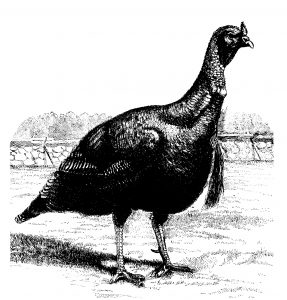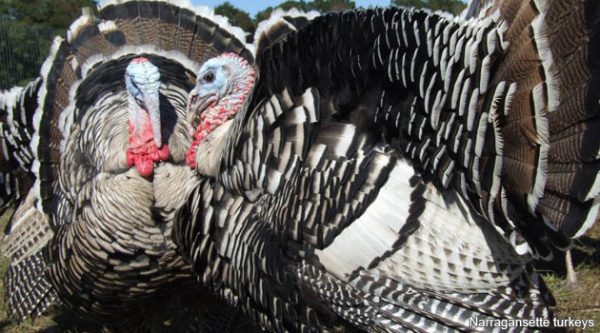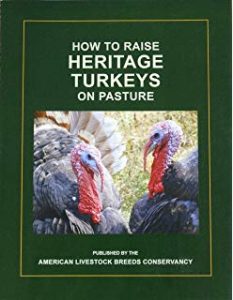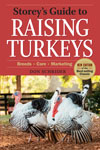
Breed Facts
Status:
Watch
Use:
Meat
Egg Color:
Pale cream to medium brown with spotting
Egg Size:
Large
Market Weight:
Male Young – 23 lbs. Mature – 28 lbs.
Female Young – 14 lbs. Mature 18 lbs.
Temperament:
Highly dependent on socialization and selection by breeder; some select for aggressive, others generally docile
Characteristics:
Can and likes to fly; can be broody; does well in cold weather.
NARRAGANSETT TURKEY
The Narragansett variety is named for the sandy Narragansett Bay in Rhode Island where it was developed. Their origins include wild turkeys and domestic turkeys that were brought to America in the 1600s by early colonists. These imported domestic turkeys may have included Norfolk Black or bronze varieties created in Europe from turkeys domesticated by indigenous Americans and taken to Europe by early Spanish explorers.
Improved and standardized for production qualities over 100 years, the Narragansett variety became the foundation of the early turkey industry in New England. Though it was valued across the country, it was especially important in Rhode Island and Connecticut.
According to an 1872 account, it wasn’t uncommon to find flocks of one to two hundred birds that were the offspring of a breeding flock of a dozen hens. Little supplemental feed was given to the turkeys; instead, they ranged for grasshoppers, crickets, and other insects. Farmers raising the turkeys were aware of the benefits of genetic selection and raised young toms that weighed between 22-28 lbs. and hens that weighed 12-16 lbs.
The American Poultry Association Standard of Perfection added the Narragansett in 1874.
While the Narragansett was never as popular as the Bronze variety, it was widely known in the Midwest and mid-Atlantic states as well as New England. Interest in the Narragansett began to decline in the early 1900s, largely replaced by Bronze turkeys as the size of turkey farms grew thanks to transportation improvements. The Narragansett was not again used for commercial production until the early 21st century.
The Narragansett color pattern contains black, gray, tan, and white feathers. Its pattern resembles that of the Bronze, with steel gray or dull black replacing the coppery bronze. White wing bars are the result of a genetic mutation that removes the bronze coloration. The Narragansett’s beak is horn-colored, its head is red to bluish-white, and its bear is black. The shanks and feet are salmon colored. The standard weight for young toms is 23 lbs and young hens weight 14 lbs. Mature toms of good bloodlines and well fed can achieve up to 28 lbs. They have excellent meat quality and flavor, despite the dark pin feathers that require additional effort to remove for optimal appearance on the table.
Narragansett hens can lay 50-100 large cream to light-brown spotted eggs in a season, with good fertility. They are one of the broodier turkey varieties, and hens are sometimes used to hatch eggs for other less-broody varieties.
Despite their heavy weight, they can (and like to) fly and they can run quickly, so if not confined or trained to go inside at night, they will roost in trees. They do well in cold weather as they were developed in New England. Narragansett turkeys have traditionally been known for their calm disposition. They do well with people and if they are well socialized may follow their owners while doing work outdoors.
This historic variety, unique to North America, merits consideration for pastured production and sustainable agriculture systems. The Narragansett turkey would make a useful and beautiful addition to the family farm.
Did you know:
No breed included on the Conservation Priority List has gone extinct since The Livestock Conservancy began work in 1977. Fourteen breeds have graduated off the CPL since 2014, including the Wyandotte chicken in 2016, Highland cattle in 2019, and Hereford pigs in 2024.

Breed Facts
Status:
Watch
Use:
Meat
Egg Color:
Pale cream to medium brown with spotting
Egg Size:
Large
Market Weight:
14 -23 lbs
Temperament:
Highly dependent on selection by breeder, Some select for aggressive, others docile
You may be interested in…




